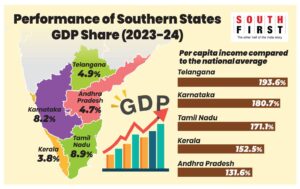Tamil Nadu has prioritised manufacturing, IT, and services as key growth drivers. Its proactive investment and entrepreneurship strategies have established many industries, boosting job creation and economic stability.
Published Sep 19, 2024 | 9:27 AM ⚊ Updated Sep 19, 2024 | 4:44 PM

Marina Beach, Chennai (iStock)
According to the recently published EAC-PM report, since the economic liberalisation of 1991, Tamil Nadu has undergone a remarkable transformation; emerging as a powerhouse in India’s economic landscape. In 2023-24, the state’s contribution to the national GDP has risen to 8.9 percent, up from 7.1 percent in 1990-91.
A case study indicates a significant increase in Tamil Nadu’s potential and strategic options to adapt and thrive in a competitive economic environment, setting the stage for its pivotal role in the southern region’s economic dynamics.
The EAC-PM Working Paper Series report suggests that the collaboration with other southern states—Karnataka, Andhra Pradesh, Telangana, and Kerala—Tamil Nadu has played a crucial role in propelling the region’s economic contributions, which now collectively account for approximately 30 percent of India’s GDP.
Also, another recent report suggests that historically, Tamil Nadu was one of the major economic hubs in India. In the 1960s, it ranked fourth in GDP contribution, with a significant share of the national economy During that era, Tamil Nadu, along with Maharashtra and West Bengal, was at the forefront of industrial development, hosting major industrial clusters in cities like Madras (now Chennai).
Baskaran Krishnamurthy, an economist, highlighted the significant contribution of southern states to India’s GDP, particularly in terms of industrial development. He noted that the south is generally better equipped to handle natural calamities, with most states providing relief without much external assistance. Socially and educationally, the southern states consistently perform above the national average in key parameters. However, in Tamil Nadu, political considerations often take precedence over economic factors, especially at the secretary level when it comes to the release of funds.
He also pointed out that, “What must be done at a secretary level must be done at a secretary level and not politically.”
Tamil Nadu has also reversed its earlier economic decline as the report shows, it has also adapted to new economic policies, thereby increasing its GDP share. The state has focused on developing its manufacturing sector, IT, and services, which have become key drivers of economic growth.
In addition to GDP contribution, Tamil Nadu’s relative per capita income has seen significant growth. As of 2023-24, the state’s per capita income stands at 171 percent of the national average. This is indicative of improved living standards and economic prosperity for its residents. In comparison, Telangana has a relative per capita income of 193.6 percent, while Karnataka’s stands at 181 percent.
Tamil Nadu’s economic resurgence since 1991 exemplifies the success of liberalisation policies and highlights the state’s vital role in India’s overall economic landscape. As Tamil Nadu continues to drive growth and innovation, it is poised to remain a key contributor to India’s GDP according to economists from Tamil Nadu.

Performance of Southern States – GDP share (2023 – 24)
(Edited by Ananya Rao)
